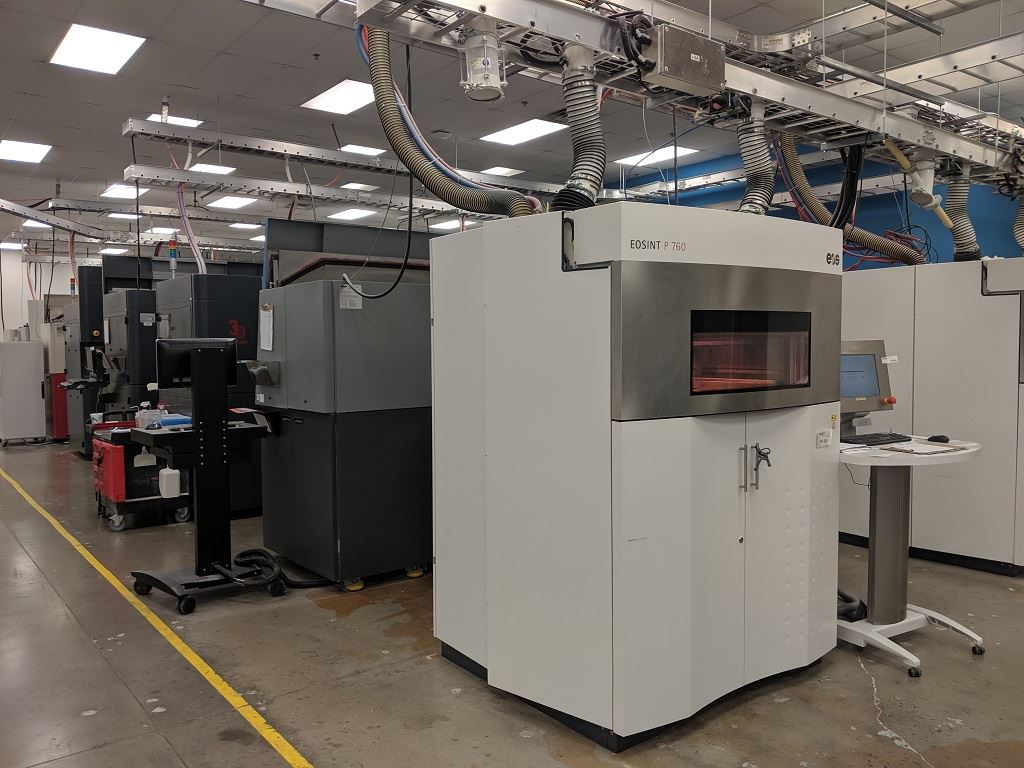![SLS 3D printers at work at Stratasys Direct Manufacturing in Belton, TX [Image: Fabbaloo]](https://fabbaloo.com/wp-content/uploads/2020/05/SDMBelton2a_img_5eb0910e3ab88.jpg) SLS 3D printers at work at Stratasys Direct Manufacturing in Belton, TX [Image: Fabbaloo]
SLS 3D printers at work at Stratasys Direct Manufacturing in Belton, TX [Image: Fabbaloo]
A lot goes into the business of contract manufacturing, and a recent visit to Stratasys Direct Manufacturing highlighted some major considerations.
As adoption of additive manufacturing continues to pick up, more and more industrial 3D printers are being installed around the world. Whether that’s a single system in a busy small business or a multi-unit setup in a high-volume service bureau, each installation requires a good amount of consideration.
It’s easy to focus only on the 3D printer and its directly associated equipment. And of course, that’s what we focus on most often here. The capabilities of industrial systems are maturing, able to handle wider ranges of materials, with output equalling or exceeding the quality seen in traditionally-made components. Customers look to the specs of a system and what it takes to deliver consistent quality, spending a good amount of time examining resolution, accuracy, repeatability, and considering pre- and post-processing needs and setup.
Industrial 3D Printing Needs
But there’s much more that goes into a successful installation, particularly for a contract manufacturer.
In addition to considering the equipment itself, contract manufacturers have to consider end-to-end operability — throughout their operations.
At Stratasys Direct’s locations in Belton and Austin, the teams were keen to point out several ways they had adapted their operations to account for the needs of high-volume additive manufacturing.
Need-Driven Solutions
In the case of multiple system setups, a bigger picture take is necessary.
Two dozen SLS 3D printers in Belton, for instance, have similar needs. Typically, an SLS machine will have a chiller nearby — that’s not the case at Stratasys Direct.
Around 2011, the team had noticed that these chillers required the most maintenance among the systems setup and installed a triple-redundant chilling system to serve every system from one location, requiring one maintenance procedure. The built-in redundancies send an email to maintenance when the system requires attention, including during low power, which is also its own concern.
“When building for aerospace, even a quick blip in power creates a cold zone and makes parts unusable,” Greg Reynolds, Vice President of Additive Manufacturing, Stratasys Direct, explained. “So in 2012 we also installed a UPS [uninterruptible power supply]. This flywheel will carry the entire power for the facility for about 30 seconds; most power outages last around 10 seconds.”
The central chilling and UPS installations were borne of needs in high-volume manufacturing, directly solving observed issues in operations.
Because they work with both polymer and metal systems and materials, there are dozens of physical systems to get to know. These are of course site-dependent; Belton for example is primarily a thermoplastic facility focused more on production, while in Austin more systems are dedicated to metal — though both have both plastic and metal setups. Understanding the ins and outs of each specific machine is critical to ensuring smooth operation.
Uptime is a crucial concern in any manufacturing endeavor, and building up on-site expertise in maintenance needs helps to ensure any delays with individual systems are quickly resolved.
The Belton team is fully trained for 100% maintenance on their 3D Systems units, for instance, ensuring they can consistently deliver to their demanding just-in-time aerospace customers. The team have also created proprietary updates to machines to ensure they get exactly the performance they need. Of course, not all 3D printer OEMs are amenable to tweaks; the deal with EOS involves a close relationship helped by physical Texan proximity that still ensure quick response to maintenance issues.
Post-processing of course also takes up floor space and dedicated focus. The large amounts of powder bed 3D printing done in Belton required a setup that could safely handle air flow, so a full wall where builds are unpacked features a compressed air backflow filtration system.
“This is a negative pressure room to keep powder flowing in one direction, kind of the opposite of a clean room,” Solutions Marketing Manager Lewis Simms said.
Other considerations for installing large-scale 3D printing lines involve issues familiar across manufacturing; think electric requirements, weight of machines, floor space, materials storage, shift rotations, traceability, quality control, shipping.
Seeing the installation setup at Stratasys Direct, though, particularly with the need-driven enhancements built up over the years, reminded me of some of the non-obvious aspects of contract manufacturing that we still need to keep in mind.
A lot more goes into additive manufacturing than just 3D printing.

